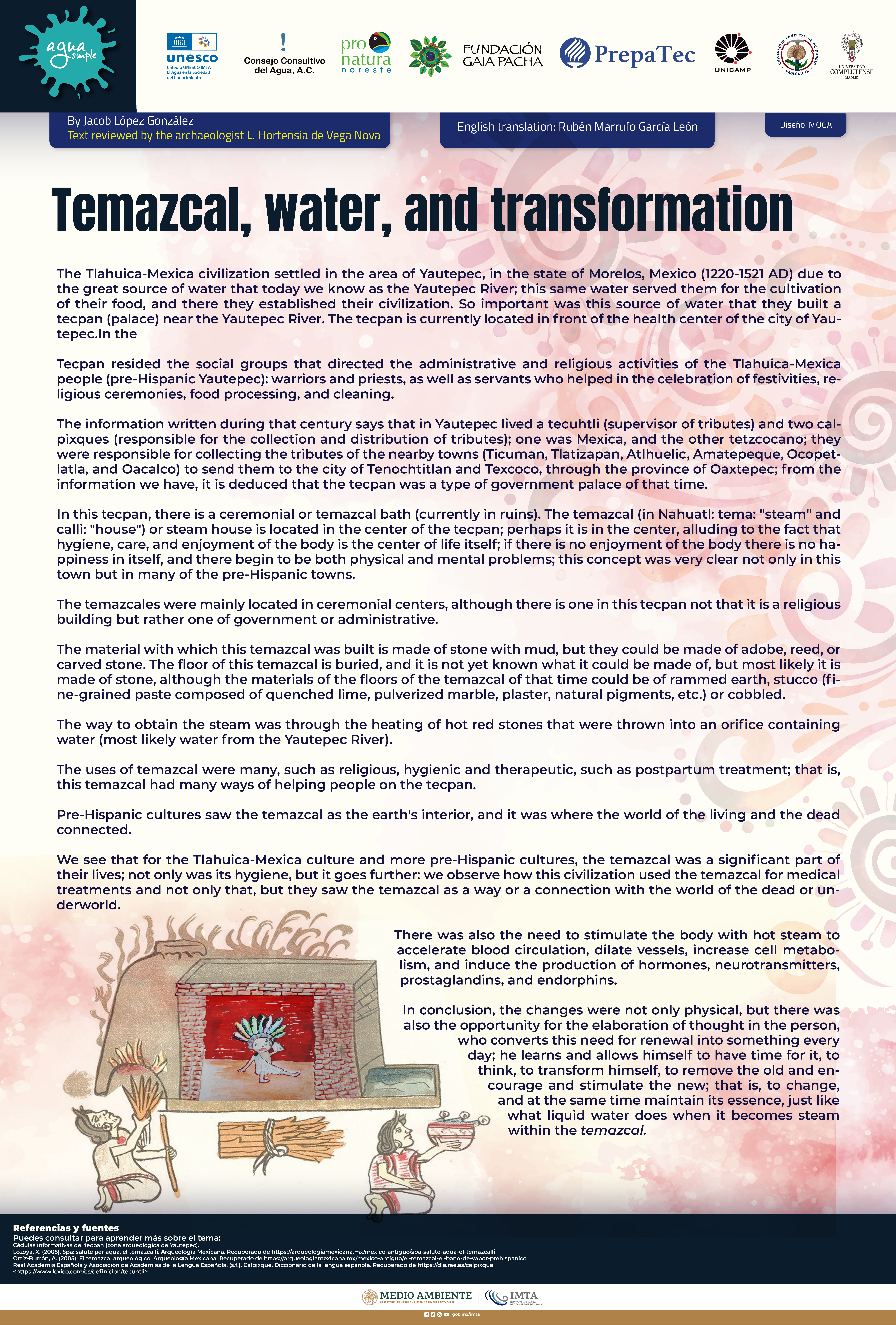Home »
Temazcal, water, and transformation
Audio en maya
Audio en náhuatl
By Jacob López González
Text reviewed by the archaeologist L. Hortensia de Vega Nova
English translation: Rubén Marrufo García León
The Tlahuica-Mexica civilization settled in the area of Yautepec, in the state of Morelos, Mexico (1220-1521 AD) due to the great source of water that today we know as the Yautepec River; this same water served them for the cultivation of their food, and there they established their civilization. So important was this source of water that they built a tecpan (palace) near the Yautepec River. The tecpan is currently located in front of the health center of the city of Yautepec.In the
Tecpan resided the social groups that directed the administrative and religious activities of the Tlahuica-Mexica people (pre-Hispanic Yautepec): warriors and priests, as well as servants who helped in the celebration of festivities, religious ceremonies, food processing, and cleaning.
The information written during that century says that in Yautepec lived a tecuhtli (supervisor of tributes) and two calpixques (responsible for the collection and distribution of tributes); one was Mexica, and the other tetzcocano; they were responsible for collecting the tributes of the nearby towns (Ticuman, Tlatizapan, Atlhuelic, Amatepeque, Ocopetlatla, and Oacalco) to send them to the city of Tenochtitlan and Texcoco, through the province of Oaxtepec; from the information we have, it is deduced that the tecpan was a type of government palace of that time.
In this tecpan, there is a ceremonial or temazcal bath (currently in ruins). The temazcal (in Nahuatl: tema: “steam” and calli: “house”) or steam house is located in the center of the tecpan; perhaps it is in the center, alluding to the fact that hygiene, care, and enjoyment of the body is the center of life itself; if there is no enjoyment of the body there is no happiness in itself, and there begin to be both physical and mental problems; this concept was very clear not only in this town but in many of the pre-Hispanic towns.
The temazcales were mainly located in ceremonial centers, although there is one in this tecpan not that it is a religious building but rather one of government or administrative.
The material with which this temazcal was built is made of stone with mud, but they could be made of adobe, reed, or carved stone. The floor of this temazcal is buried, and it is not yet known what it could be made of, but most likely it is made of stone, although the materials of the floors of the temazcal of that time could be of rammed earth, stucco (fine-grained paste composed of quenched lime, pulverized marble, plaster, natural pigments, etc.) or cobbled.
The way to obtain the steam was through the heating of hot red stones that were thrown into an orifice containing water (most likely water from the Yautepec River).
The uses of temazcal were many, such as religious, hygienic and therapeutic, such as postpartum treatment; that is, this temazcal had many ways of helping people on the tecpan.
Pre-Hispanic cultures saw the temazcal as the earth’s interior, and it was where the world of the living and the dead connected.
We see that for the Tlahuica-Mexica culture and more pre-Hispanic cultures, the temazcal was a significant part of their lives; not only was its hygiene, but it goes further: we observe how this civilization used the temazcal for medical treatments and not only that, but they saw the temazcal as a way or a connection with the world of the dead or underworld.
There was also the need to stimulate the body with hot steam to accelerate blood circulation, dilate vessels, increase cell metabolism, and induce the production of hormones, neurotransmitters, prostaglandins, and endorphins.
In conclusion, the changes were not only physical, but there was also the opportunity for the elaboration of thought in the person, who converts this need for renewal into something every day; he learns and allows himself to have time for it, to think, to transform himself, to remove the old and encourage and stimulate the new; that is, to change, and at the same time maintain its essence, just like what liquid water does when it becomes steam within the temazcal.
Sources:
You can consult the following sources to learn more about the subject:
Cédulas informativas del tecpan (zona arqueológica de Yautepec).
Lozoya, X. (2005). Spa: salute per aqua, el temazcalli. Arqueología Mexicana. Recuperado de https://arqueologiamexicana.mx
Ortiz-Butrón, A. (2005). El temazcal arqueológico. Arqueología Mexicana. Recuperado de https://arqueologiamexicana.mx
Real Academia Española y Asociación de Academias de la Lengua Española. (s.f.). Calpixque. Diccionario de la lengua española. Recuperado de https://dle.rae.es


